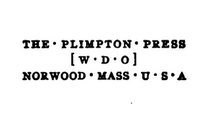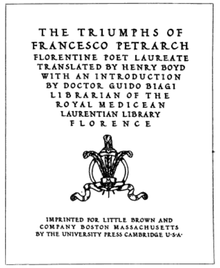William Dana Orcutt
| William Dana Orcutt | |
|---|---|
|
Portrait of William Dana Orcutt published in the Minneapolis Journal, April 9, 1904 | |
| Born | West Lebanon, New Hampshire |
| Died | Boston |
| Occupation | Book designer, author |
| Nationality | American |
William Dana Orcutt (1870-1953) was an American book designer, typeface designer, historian, and author.
Biography
William Dana Orcutt was an important book and typeface designer in Boston, an important printmaking and bookmaking center, in the late nineteenth and early twentieth century. Orcutt graduated from Harvard University in 1892,[1] and subsequently worked for John Wilson, proprietor of The University Press of Cambridge, Massachusetts (a forerunner of the Harvard University Press). Through his role at the University Press, Orcutt made contact with prominent authors such as Mary Baker Eddy, whose books he continued to publish throughout her career.[2] Along with several other important designers and printers such as Daniel Berkeley Updike and Bruce Rogers, Orcutt helped found the Boston Society of Printers in 1905. Orcutt was elected the first president of the Society, an organization inspired by the principles of the Arts and Crafts movement.

In 1910, Orcutt left the University Press to join The Plimpton Press in Norwood, Massachusetts.[3] During Orcutt's tenure at the press, he worked to change the nature of printing "from a contracting to a manufacturing business", believing that this "rais[ed] the quality of the so-called 'trade' volumes".[4] The Plimpton Press centralized the diverse functions of bookmaking including composition (typesetting), printing, binding, etc. Based on his experience at The University Press and his reputation as a designer and printer, Orcutt was personally sought out by authors to print their works. For example, the Victorian nutritionist and dietician Horace Fletcher bequeathed Orcutt his library so that Orcutt would publish Fletcher's manuscripts.[5]
Orcutt also published several works of his own on writing, book making and book arts and remained active in professional societies related to printing and typography. A self-described "bookman," Orcutt wrote, reviewed, and translated for a variety of publications based in the Boston area including The Atlantic Monthly, The Christian Science Monitor, and The Boston Globe. In an important review article first published in a special issue of the International Studio magazine and then republished in 1914 in a book-length collection, Orcutt surveyed the recent history of "The Art of the Book in America".[4] He praised work by important designers and printers such as Updike, Rogers, and Theodore Low De Vinne. In Orcutt's account, American printing had reached a pinnacle of excellence during the 1860s but had fallen into decline—technically and artistically—until a revival of interest spurred by the work of William Morris in the 1890s.
Typefaces
Typefaces designed by Orcutt include Humanistic, which was cast for the University Press in Cambridge, Massachusetts by the American Type Founders Company, French Round Face, and Suburban French.[6]

The Humanistic typeface was probably Orcutt's most important creation. The typeface is based on a 15th-century manuscript of the Aeneid attributed to the notable Humanistic scribe Antonio Sinibaldi held at the Laurentian Library in Florence.[7] Orcutt traveled to Italy to study typographic history and developed a friendship with Guido Biagi, Director of the Laurentian Library,[8] who directed his interest to Renaissance Italian lettering. A special limited printing of a book on Petrarch, titled The triumphs of Francesco Petrarch, Florentine poet laureate, published in 1906, served as the occasion to commission and create this typeface.[9] Charles Eliot Norton, Professor of Art History at Harvard and expert on Italian art and literature, reviewed designs of the typeface and later praised "the attractive freedom and unusual grace in its lines, derived immediately from the manuscript model but adapted to the necessary rigid requirements of print".[9][10]
The Triumphs was a painstaking work of historical reconstruction and fine typesetting, including ink prepared exactly according to the methods of 15th-century Italian scribes.[11] Orcutt reflected on the process of creating this typeface in his 1926 work In quest of the perfect book.[12] Orcutt's Humanistic was adapted by the British foundry Stephenson Blake as Bologna in 1946, which in turn became American Type Founders' Verona (with lining figures) in 1951.
Books
Orcutt authored books in a variety of genres ranging from novels to historical fiction, biography, and writing advice.
- The Writer's Desk Book: Being a Reference Volume Upon Questions of ... Frederick A. StokesCompany. 1912.
- Burrows of Michigan and the Republican Party: A Biography and a History. Longmans, Green and Co. 1917.
- The manual of linotype typography, prepared to aid users and producers of printing in securing greater unity and real beauty in the printed page;. Brooklyn, N.Y.: Mergenthaler linotype Co. 1923.
- In quest of the perfect book : reminiscences & reflections of a bookman. Boston: Little, Brown. 1926.
- The magic of the book; more reminiscences and adventures of a bookman. Boston: Little, Brown & Co. 1930.
- From my library walls; a kaleidoscope of memories,. New York; Toronto: Longmans, Green and Co., inc. 1945.
- Mary Baker Eddy and her books. Boston: Christian Science Pub. Society. 1950.
References
- ↑ Harvard University. Class of 1890 (1915). Twenty-fifth anniversary report, 1890-1915. Norwood, Mass., Priv. print. for the Class by the Plimpton Press. Retrieved 2013-03-17.
- ↑ The Mary Baker Eddy Library (2012). ""I never doubted": Mary Baker Eddy and her printers". The Mary Baker Eddy Library.
- ↑ Orcutt, William Dana; Plimpton Press, Mass.) University Press (Cambridge (1910). [Announcement of William Dana Orcutt's retirement from the University Press and his joining the Plimpton Press, 3 January 1910]. Norwood, Mass.: Plimpton Press. Cite uses deprecated parameter
|coauthors=(help) - 1 2 Orcutt, William Dana (1914). "The Art of the Book in America". The art of the book: a review of some recent European and American work in typography, page decoration & binding. London; New York: "The Studio" Ltd.
- ↑ "New-York tribune. (New York [N.Y.]) 1866-1924, March 27, 1919, Image 7". 1919-03-27. p. 7. ISSN 1941-0646. Retrieved 2013-03-17.
- ↑ McGrew, Mac (1986). American metal typefaces of the twentieth century. New Rochelle, N.Y.: Myriade Press. ISBN 9780918142207.
- ↑ Ullman, B. L. (1974). The Origin and Development of Humanistic Script. Ed. di Storia e Letteratura.
- ↑ Orcutt, Reginald (2005). "This I Believe". This I Believe.
- 1 2 "Collection concerning the publication of The triumphs of Francesco Petrarch ..., 1903-1941.". OCLC. Retrieved 17 February 2013.
- ↑ Norton, Charles Eliot (1906). "The New Humanistic Type". The Printing Art. 6. Cambridge: University Press.
- ↑ BROOKS, JEROME E. (1926-12-12). "Adventures in Typography, or An Esthetic Pilgrimage: William Dana Orcutt Tells of the Arduous Research Which Preceded His "Perfect Book" IN QUEST OF THE PERFECT BOOK, REMINISCENCE AND REFLECTIONS OF A BOOKMAN. By William Dana Orcutt. Colored frontispiece and 84 facsimiles, reproductions and other illustrations. 317 pp. Boston: Little, Brown & Co. $5.". New York Times. New York, N.Y., United States. ISSN 0362-4331. Retrieved 2013-03-17.
- ↑ In quest of the perfect book : reminiscences & reflections of a bookman. Boston: Little, Brown. 1926.
External links
- Works by William Dana Orcutt at Project Gutenberg
- Works by or about William Dana Orcutt at Internet Archive
